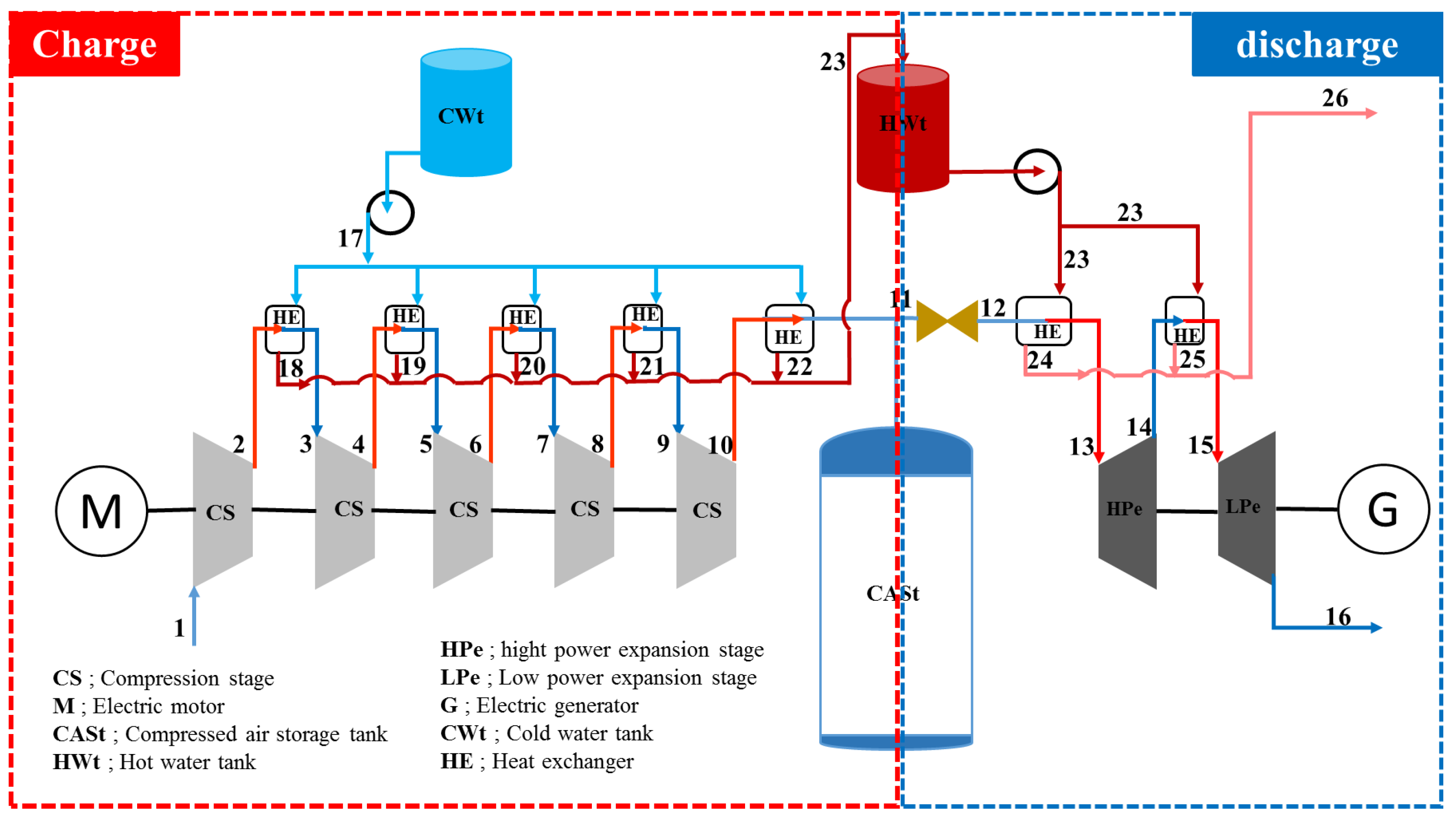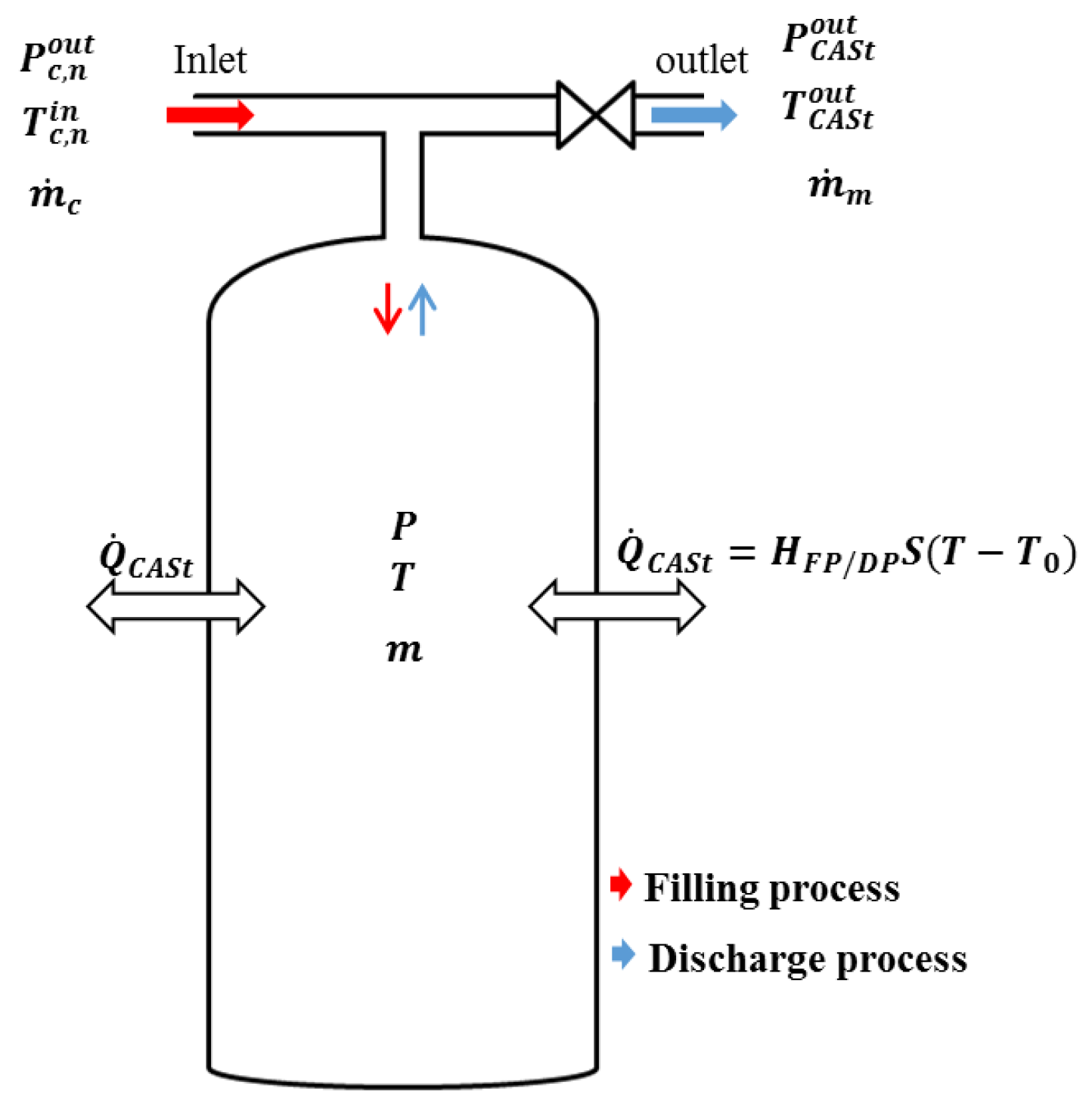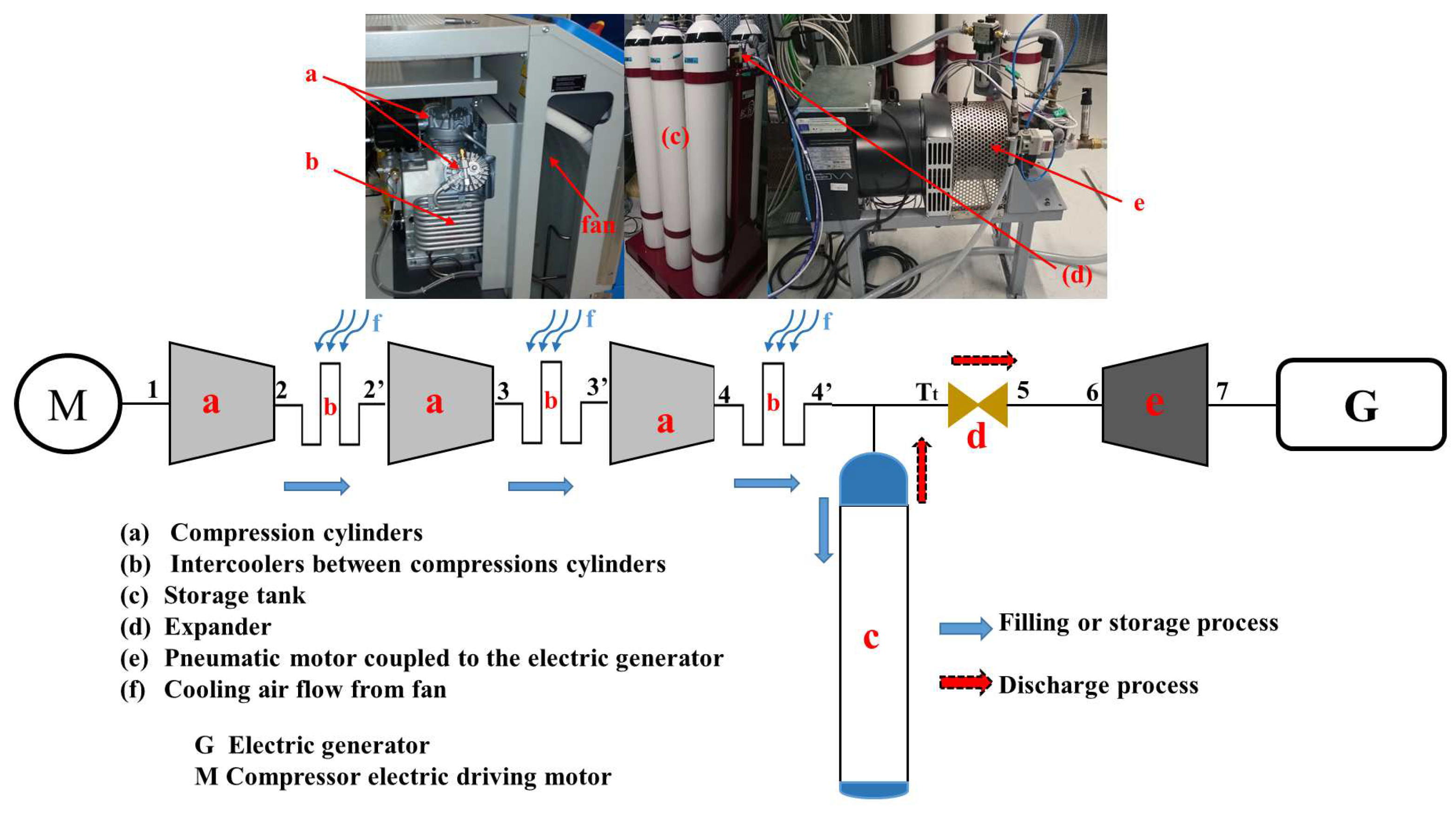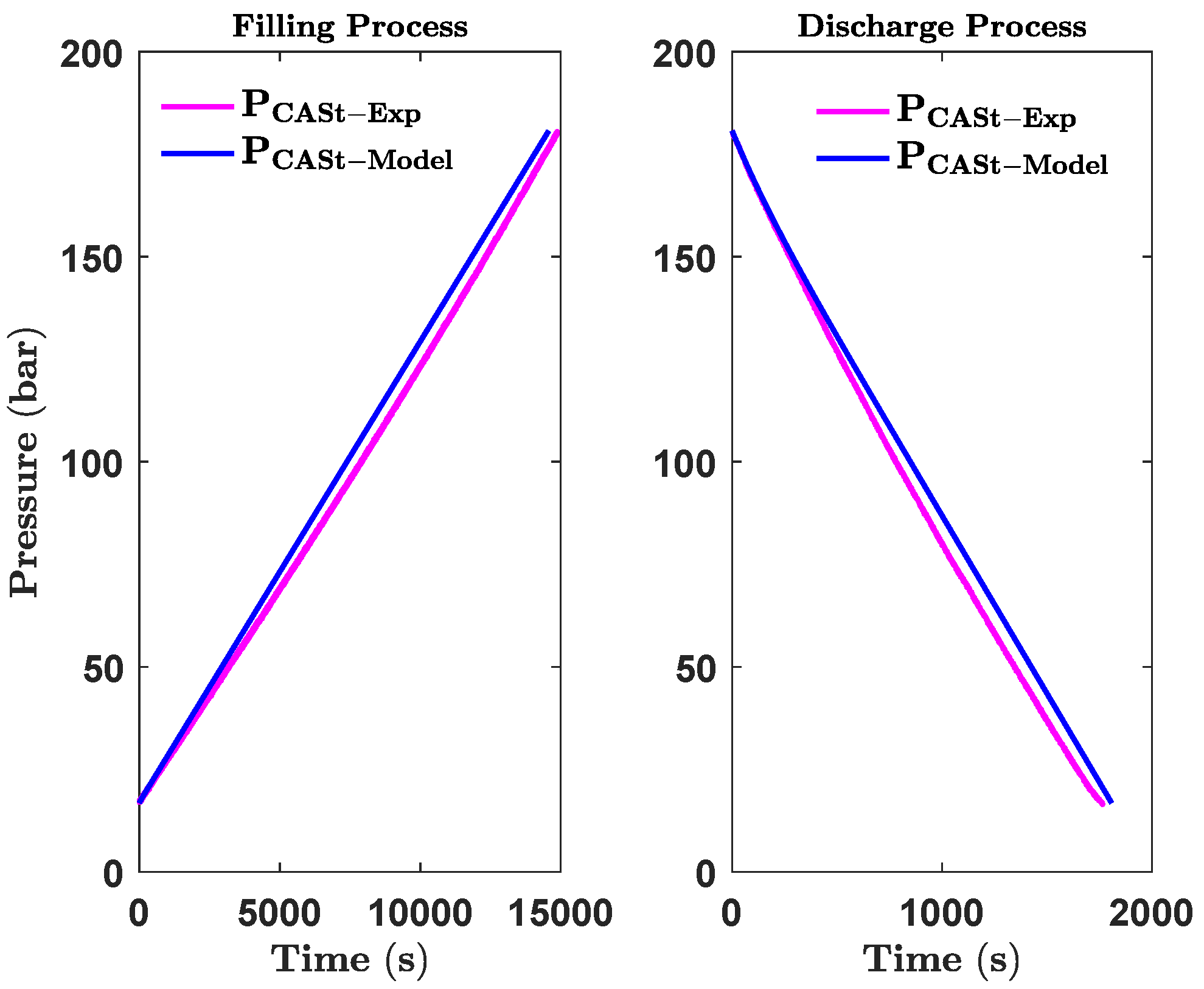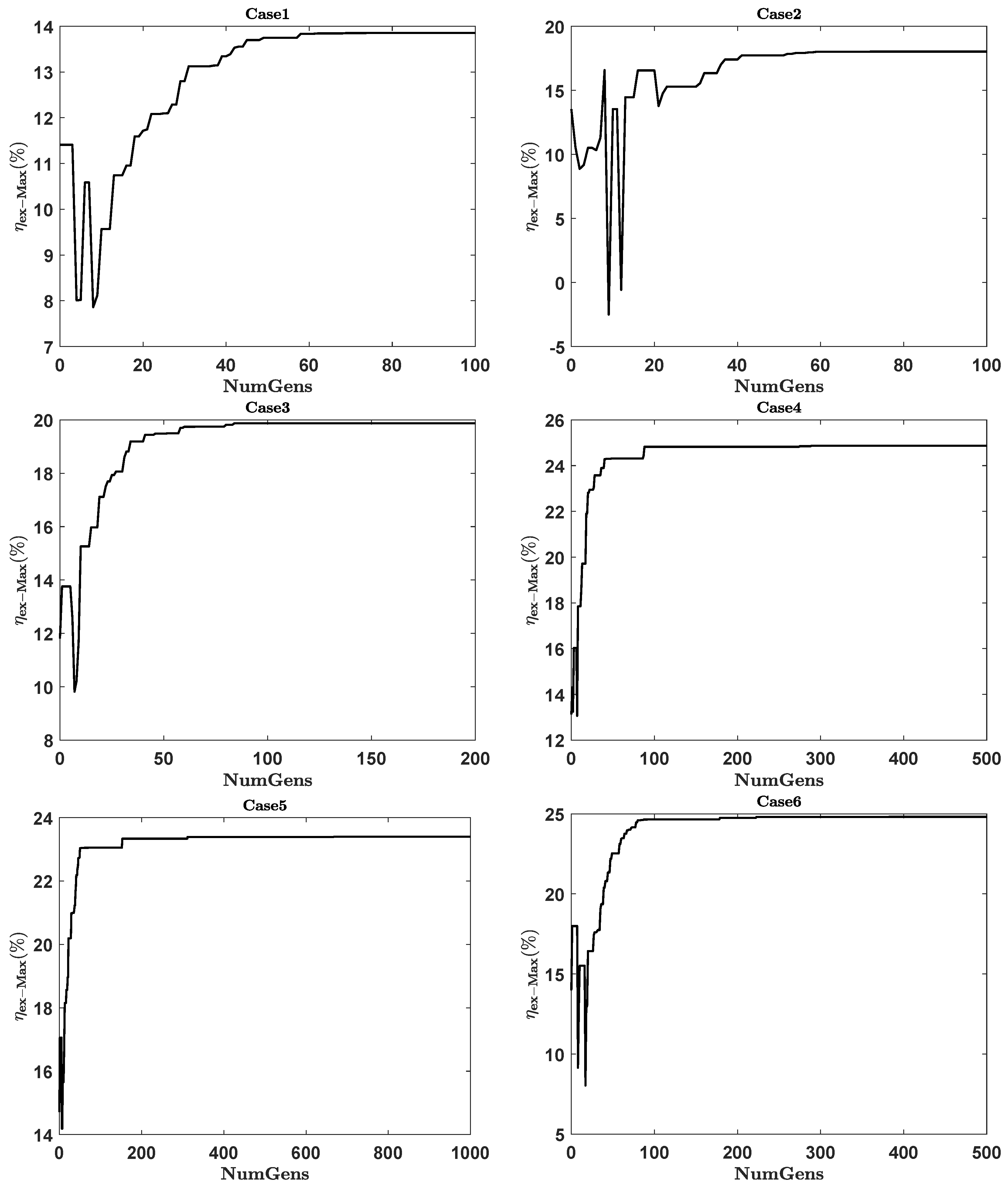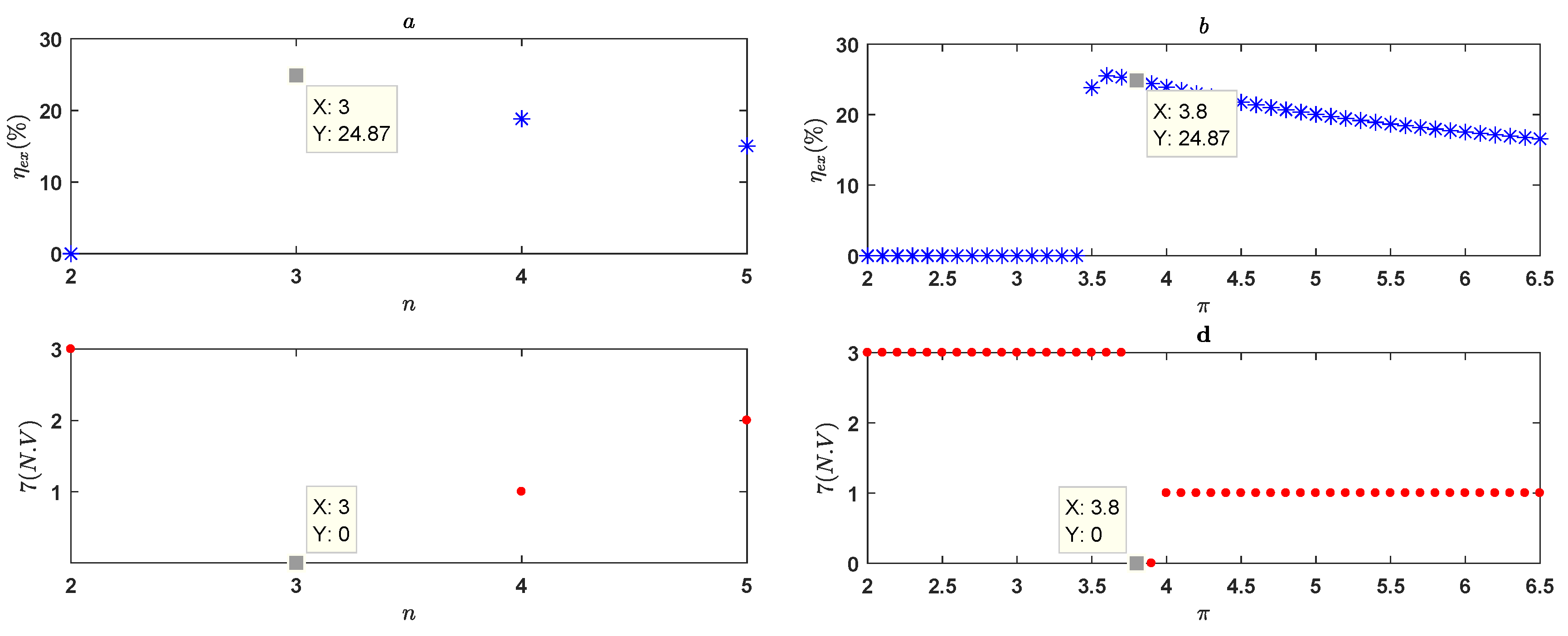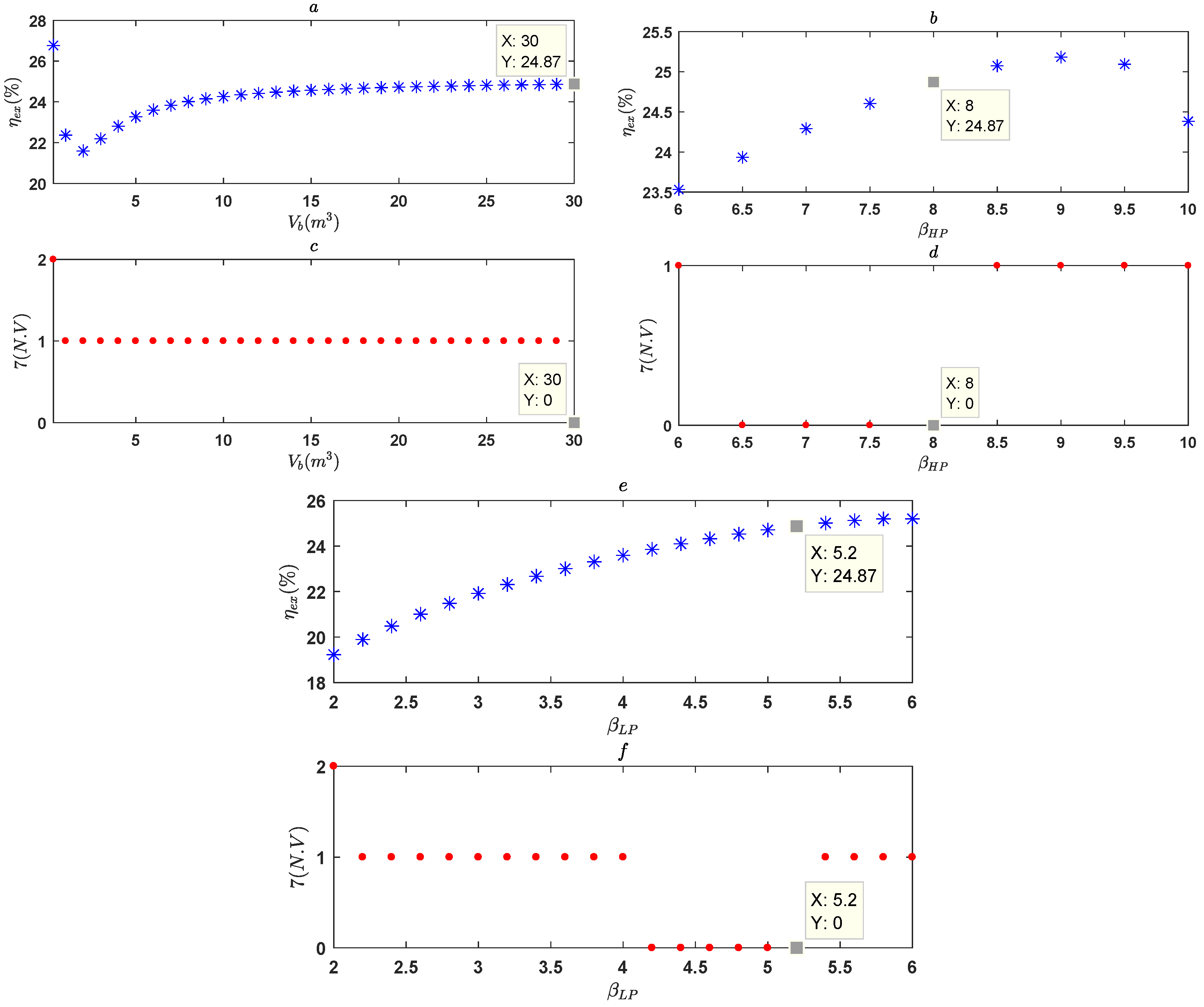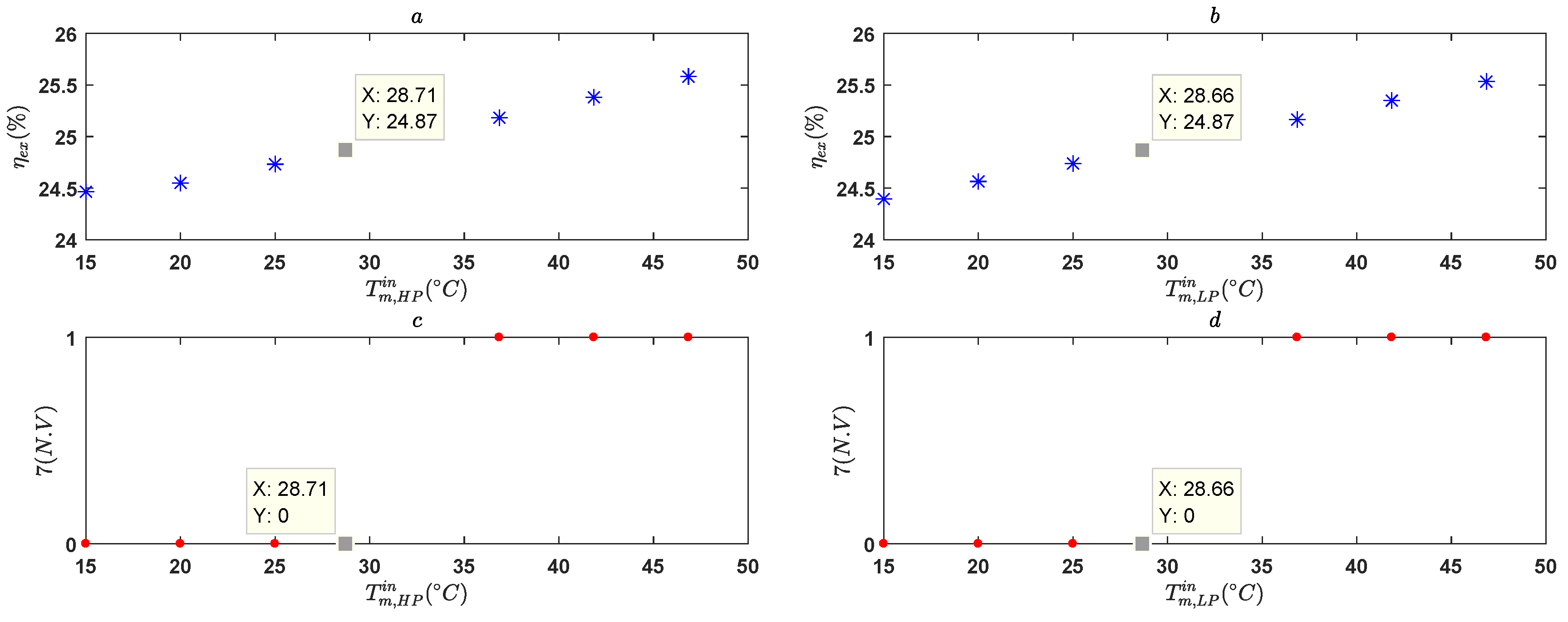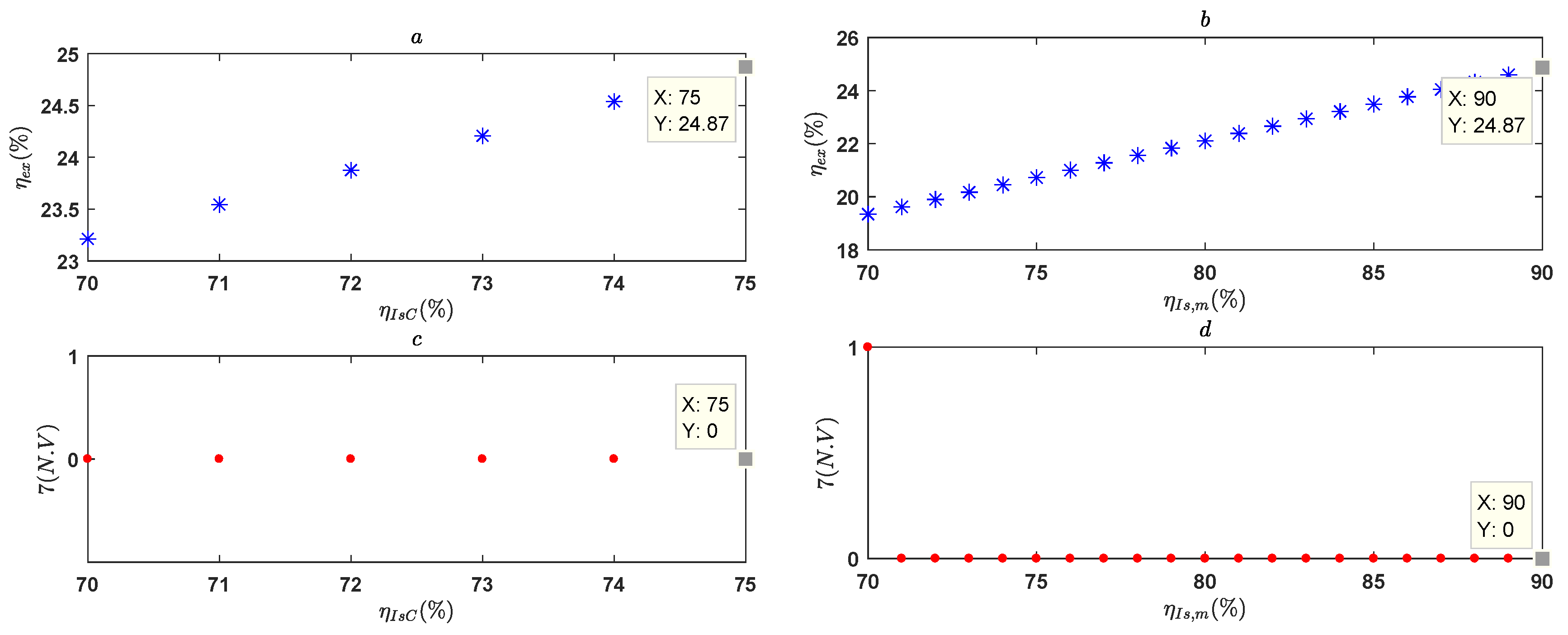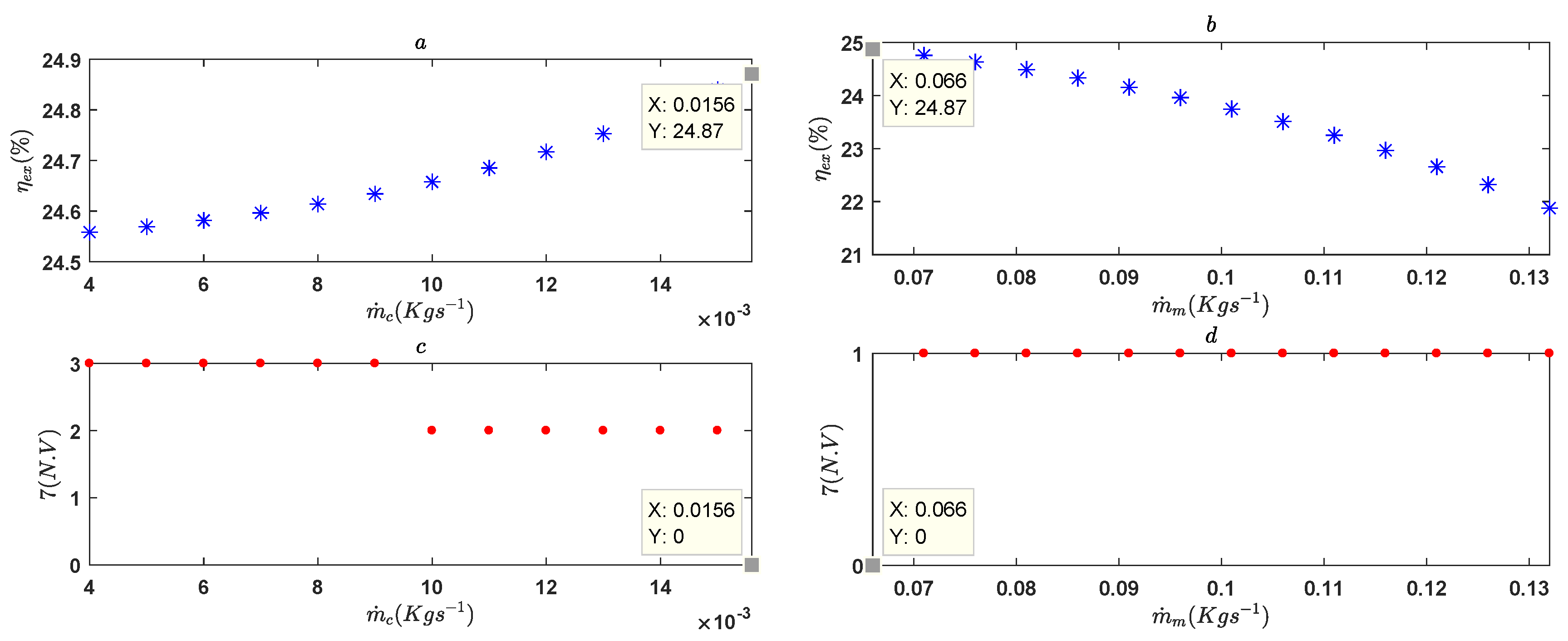6.1. Optimization Results
In this section, the results of optimization and thermodynamic analysis of optimized system are presented. The simulation code was implemented under MATLAB
. To understand the impact of RCGA parameters to the optimization procedure, we have distinguished six cases with respect to the population size change and change of the number of maximum generation as shown in
Table 5; Here
is the size of population,
is the maximum number of generations,
is the probability of crossover and
is the probability of mutation. In all these cases, the probability of crossover and that of mutation are the same and equal respectively to 60% and 0.5%. The population size in Case 1 is 50 and the maximum number of generations is 100. For more diversity in initial population, the population size is doubled in Case 2 for the same maximum number of generations. In Cases 1 through 5, the population size is held constant at 100 and the evolution time is increased gradually by raising the maximum number of generations from 200 for Case 3 to 1000 for Case 5. Finally, in Case 6, for the purpose of observing the impact of diversity in the initial population on finding an optimal solution, the population size is doubled with the same maximum number of generations as in Case 4 (500).
The evolutions of the maximum value of the objective function (
) in each generation for these six cases have been plotted as show in
Figure 6 where
is the number of generations.
It can be seen in Case 1 of
Figure 6 that, a stable value of 13.85% is reached for minimum generation number of 70, but this value remains stable for at least 30 generations after the plateau is reached. Therefore, we are not sure whether this stable value is the global optimum of the storage system. One possible explanation of this late convergence may be the lack of diversity of the initial population. Therefore, in Case 2, the population size is doubled with the same maximum number of generations. The representative curve of this second case shows that; the population is gradually converging to the stable objective value of 18.02% which is the maximum value of the exergy efficiency reached during all the evolution process. Also, this value is reached for minimum generation number of 72 just 28 generation before the maximum number of predefined generations. Therefore, it is not certain that this maximum exergy efficiency of 18.02% is the optimum solution because the evolution process may not be completed. Therefore, in Case 3, the maximum generation number is doubled with the same population size as in Case 2 to maintain good diversity in the population and a sufficient evolution time to expect a convergence towards the overall optimum. The result of this case shows that the population is converging to a stable value of exergy efficiency. However, it is not sure whether this maximum stable value of 19.88% is the global optimum since, as can be seen, by doubling the evolution times (
), the maximum value of exergy efficiency is increased by two percentage points (from 18.02% to 19.88%). That is why, in the fourth case, the evolution time has increased fivefold (
) while keeping the same diversity in the initial population as in the third case (
).The result of this fourth case shows that the population is converging to a stable value of maximum exergy efficiency that increases by five percentage points to 24.87% in Case 4, compared with 19.88% in case 3. This maximum value of 24.87% remains constant over the last 210 generations during evolution process. It is likely that the algorithm has converged to the global optimum solution. To make sure of that, we wanted to see whether increasing the evolution time could be able to have an impact on the maximum value of the exergy efficiency. Therefore, in the fifth case, the maximum number of generations is doubled (
) with the same population size as in the previous case. As shown in the representative curve of the evolution process of this fifth case, the population converges to a stable value but this stable value of 23.40% is unfortunately lower than that obtained in Case 4. Since an evolution time beyond 500 generations does not have a relevant impact on the maximum value of exergy efficiency, in the last case, the population size used in the fourth case is doubled (for more diversity in the initial population) with the same maximum number of generations. The stable value of maximum exergy efficiency of 24.81% obtained at the end of evolution process was indeed close to that reached in Case 4. Nevertheless, this value remains lower than 24.87% of Case 4 which is certainly the global optimum of this optimization problem.
To return to Case 4, the observation of the final population at the end of the evolution process shows that, all the chromosomes (sets of design parameters) are identical. This means that almost all the chromosomes of the population have converged to the optimum solution. We have then deduced the set of optimal values of influencing parameters that maximizes the global exergy efficiency of the SS-CAES system without fossil fuel used. These optimal parameters are given in
Table 6.
Using these optimal parameters, the thermodynamic properties of each point in the optimized system (
Figure 7) are shown in
Table 7. The performance indicator of the optimized system is calculated and shown in
Table 8.
As can be seen in
Table 8, under optimal design conditions, the compressors take
to fill the CASt while the discharge time of the CASt is equal to
. The electric power produced by the generator is
kW which is well above the electrical energy requirements of an average household (of about 4 individuals). The optimized system also produces
of hot water at a temperature of about 30
C during each cycle of charge/discharge which can be used for heating purposes in a house. The RTE of the optimized system is equal to 79.07% and its exergy efficiency is 24.87%. By calculating the contribution of thermal energy to RTE (CTEtoRTE, Equation (
49)), we can see that it represents about 69% of RTE. Unfortunately, the low-temperature hot water containing this thermal energy does not necessarily have the same value as the electrical energy produced during the discharge process. This is one more reason to use the overall exergy efficiency as a performance evaluation criterion of SS-CAES system proposed in this work.
To identify the locations and magnitudes of storage process inefficiencies, the total exergy destruction of the charge/discharge cycle for each component as well as their exergy destruction ratio are listed in
Table 9.
As shown in
Table 9, the compression stage has the largest exergy destruction, followed by the intercoolers. This can be explained by the fact that, the temperature difference between the inlet and the outlet of each stage is large enough so that the heat transfer to the compression stages walls is no longer negligible compared to the enthalpy change. Another explanation could be given by the advanced exergetic analysis [
59,
60]. It would certainly indicate that the unavoidable exogenous part of the exergy destruction within these components is important. Indeed, as shown in
Table 6, the design of compressor is supposed to be perfect because of the higher values of efficiency (isentropic and mechanical). Thus, the unavoidable endogenous part of the exergy destruction within the compressor is low compared with the unavoidable exogenous part.
6.2. Distribution of Design Parameters
The behavior between lower and upper bounds (dotted lines in
Figure 8 and
Figure 9) of each optimal design parameters during the evolution is analyzed in this section. The results of this are shown in
Figure 8 and
Figure 9).
According to this distribution, it can be seen in
Figure 9g that the pneumatic motor mass flow rate reaches its minimum value. This means that the decreased value of this design variable could improve the global exergy efficiency of system. To reduce the number of variables and thus to speed up the optimization script, the lower born value of the pneumatic motor mass flow rate can be selected and set as a constant.
As also shown in
Figure 9b–e concerning respectively the distribution in the population during the evolution process, of the values taken by the isentropic efficiency of compressor, by the isentropic efficiency of pneumatic motor, by the mechanical efficiency of compressor and by the mechanical efficiency of pneumatic motor; during the evolution process, these four design parameters only take almost exclusively their maximum value. This means that, the increased value of these designs variables could improve the global exergy efficiency of system. Similarly, the upper born value of these four designs parameters can be selected and set as a constant.
Other design variables have the scattered distribution which mean that, their variations could have some significant impact on the system performance. To have an idea of these impacts on both global exergy efficiency and number of violated constraints at the optimal point, the sensitivity analyses have been made.
6.3. Effect of Variation of the Design Variables Value on the System Efficiency (Global Exergy Efficiency) and on the Number of Violated Constraints
In this section, we study the effect of variation of the design variables value on the system efficiency and on the number of violated constraints. For this purpose, we vary the value of each design variable in its allowable range specified in
Table 2.
6.3.1. Number of Compression Stages and the Compression Ratio Values
Figure 10a shows the decrease of the global exergy efficiency with the increasing number of compression stages at fixed optimal compression ratio. The same trend is observed in
Figure 10b for the compression ratio at fixed optimal number of compression stages but, unfortunately, the compression ratio values which provide a maximum exergy efficiency violate some imposed constraints. That is why, as shown in
Figure 10c,d, the optimum values of these two design parameters do not violate any constraint.
Thus, for a SS-CAES system, it is not necessary to use more than three compression stages. Furthermore, the compression ratio value of these compression stages should not exceed four.
6.3.2. Volume of the Air Storage Tank
As can be seen in
Figure 11a, the increase in volume of the air storage tank results in an increase of the global exergy efficiency. However, before the optimal value is reached, all other values violate one constraint as shown in
Figure 11c. This means that if it had been possible to have a larger tank, the system efficiency would have been greater than the optimal value obtained. However, for a given SS-CAES system, a trade-off must be found between the constraints of space, of charging time, of discharge time and even of the cost of purchasing the storage tanks. Therefore, the optimal value of the air storage tank volume is closely linked to the imposed constraints of the system.
6.3.3. Pressure Ratio Values of High-Pressure and the Low-Pressure Expansion Stages of Pneumatic Motor
As it is shown in
Figure 11b,e, the exergy efficiency increases almost linearly with both the pressure ratio of high-pressure and the low-pressure expansion stages of pneumatic motor. However, when the value of pressure ratio of high-pressure expansion stage is greater than 9, the global exergy efficiency begins to decrease (
Figure 11b). This can be explained by the low temperature taken by the air at the exit of such expansion stage. In fact, the temperature of hot water produced during compression process is not high enough. Thus, the preheating of air between the expansion stages will no longer be enough to improve the expansion work of the low-pressure stage. Finally, imposed constraints (the minimum power delivered by the storage system during discharge process and the minimum difference between the hot water temperature and the inlet temperature of air of expansion stages) justify the optimal values returned by the optimization algorithm (
Figure 11d,f).
For a SS-CAES system using pneumatic motor as expansion system, it is possible to increase its efficiency by using the pressure ratio values of 9 and 6 for the high-pressure and the low-pressure expansion stages, respectively. However, it should be considered in this case to use a water heating system (like solar water heaters) outside of the SS-CAES system. This water heating system would be used to increase the temperature of the hot water produced during the compression process.
6.3.4. Inlet Temperature Values of High-Pressure and the Low-Pressure Expansion Stages of Pneumatic Motor
As shown in
Figure 12a,b, the exergy efficiency increases linearly with both the inlet temperature of high-pressure and low-pressure expansion stages of pneumatic motor. Moreover, the optimal values of these two design parameters returned by the GA are the last ones which do not violate any of the imposed constraints (
Figure 12c,d). If the temperature of the hot water had been higher, the optimal values of these two variables would have been higher too.
For a given SS-CAES, only thermomechanical stresses should limit the supply temperature of the expansion stages. Thus, when designing a SS-CAES using pneumatic air motor, consideration should be given, if necessary, to an external water heating system. In that case, during the preheating of the supplying air of the expansion stages during the discharge process, it is possible to move closer to the maximum permissible temperature at the inlet of these stages.
6.3.5. Compressor and Pneumatic Motor Isentropic Efficiency Values, of the Compressor and Pneumatic Motor Mechanical Efficiency Values
As it is shown in
Figure 13a,b and
Figure 14a,b respectively, the increase in the isentropic and mechanical efficiency of compressor and pneumatic motor leads to a linear increase of the exergy efficiency. Furthermore, it is important to note that this increase is done without any violation of constraints (
Figure 13c,d and
Figure 14c,d). Therefore, the maximum values of these four design parameters can be selected and set as constants in the cost function for optimization.
We should remember, however, that these results were predictable since for an energy system having turbomachines, the higher is the isentropic efficiency (or mechanical efficiency), the higher will be the system efficiency. Nevertheless, by including these four parameters among the optimization parameters, we are assessing the smooth functioning of the modified RCGA proposed in this work.
6.3.6. Compressor and Pneumatic Motor Mass Flow Rate Values
Figure 15a shows that the global exergy efficiency increases with the compressor mass flow rate. In addition, the single value that does not violate any constraint is that returned by the optimization algorithm (
Figure 15c). Unfortunately, its scattered distribution (
Figure 9f) does not allow one to set it as constant during the optimization procedure. Nevertheless, when designing a SS-CAES system, it would be appropriate to give preference to a compressor with a high mass flow rate.
For the pneumatic motor mass flow rate, its increase leads to a decrease in global exergy efficiency (
Figure 15b) and as in the case of compressor mass flow rate, the optimum value of this parameter returned by optimization algorithm is the only one that does not violate any constraint (
Figure 15d). In contrast to the scattered distribution of the compressor mass flow rate, a homogeneous convergence towards the minimum value can be noted in
Figure 9g. Therefore, this minimum value of the pneumatic motor mass flow rate can be selected and set as a constant in the optimization algorithm. When designing a SS-CAES system, it would be appropriate to give preference to a pneumatic motor with a low mass flow rate.
